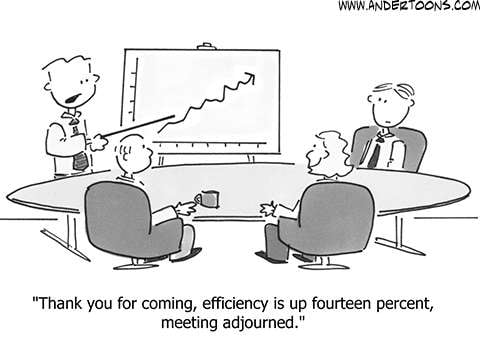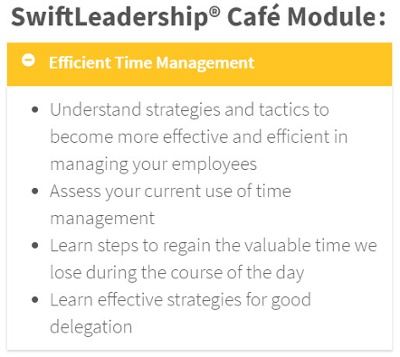
Most leaders recognize the need for efficient time management and seek out advice on how to solve their daily workplace woes. What they find, however, is often just a list of quick-fix ideas designed to treat the symptoms of deeper organizational shortcomings rather than ways to fix the underlying issues causing them.
In the same way that treating the symptoms of a disease instead of the disease itself will bring relief without a cure, these managers remedy their biggest pain points (a never-ending stream of emails, meetings stacked on other meetings, constantly changing to do lists, etc.) for a time and later find themselves back where they started. For instance, many supervisors have spent time putting together rigid plans for checking their email less frequently or scheduling meetings more intentionally in the name of time management efficiency. Then, after a few weeks or months, these plans are abandoned or end up failing when they are exposed to workplace pressures.
“Instead of trying to fit all the pieces into their day more efficiently, leaders must push for the changes that will allow them to have fewer pieces to fit in.”
In lieu of a “better” plan to improve time management, what supervisors need is a cure for the forces driving this need for greater efficiency. Instead of trying to fit all the pieces into their day more efficiently, leaders must push for the changes that will allow them to have fewer pieces to fit in.
Taking an organizational approach to efficient time management involves pushing for top-down change by:
Eliminating Unnecessary Meetings
Traditional advice: Schedule meetings with buffer space so that meetings running over do not encroach on subsequent meetings, hurting efficiency throughout the day.
 Gaps throughout the day may provide a well-needed respite from an endless string of meetings, but they also create time inefficiencies. Unfilled micro time slots become pits of inefficiency because the break is just long enough to pull your mind off a topic but not long enough to get meaningful work done.
Gaps throughout the day may provide a well-needed respite from an endless string of meetings, but they also create time inefficiencies. Unfilled micro time slots become pits of inefficiency because the break is just long enough to pull your mind off a topic but not long enough to get meaningful work done.
Instead of compounding the damage that too many meetings have on overall efficiency by devoting more time to them, strive to reduce the number of meetings employees must attend.
Create a company culture that values employees’ time by eliminating the “Monday morning meeting” and other recurring status meetings that could be better accomplished through an email. When meetings are necessary, pay close attention to the attendee list and only invite essential personnel. Anyone that should be informed about what happened at the meeting but will not need to contribute can be updated by email afterwards.
Better Defining Roles
Traditional advice: Conduct a time audit so you understand where you are spending your time and then assign strict time limits to each task.
Many of the tasks assigned to employees that take up considerable time are unavoidable, but re-work is a highly avoidable time management killer. Better defining employee roles eliminates job overlap that leads to re-work. This is especially important at smaller businesses where employees wear more hats and high-growth companies where employees are stretched thin. Firmly outlined positions not only inform individual employees of their duties, but also highlight areas where additional staff is needed, making future hiring easier.
Hiring More Staff
Traditional advice: Learn how to delegate.
While some supervisors fail to delegate because they prefer to be hands-on, others simply have no one to delegate to because the employees under them are too busy to take on additional work. Not only should employees’ roles be clearly defined, but their capacity needs to be tracked as well.
Understanding who has the availability to take on additional responsibilities is the first step to delegating. Managers who are averse to relinquishing control will find that they are more confident about delegating when they know that the people who are receiving the extra work are able to accept it. In cases where existing staff’s skillsets do not match the needs of work that must be offloaded, existing personnel should be trained, or new personnel should be hired to fill this need.
Reducing Urgent Project Requests
Traditional advice: Better prioritize tasks to meet deadlines and achieve goals by planning for the following day before leaving each evening.
Constantly shifting to-do lists is a symptom of inconsistent deadlines and goals. Employees that constantly feel like they are chasing critical, time-sensitive deliverables are apt to burn out quickly. But instead of weathering the storm better, employees need a manager who will be their umbrella.
Reducing the number of urgent project requests is an organizational initiative that has major time management implications. Providing transparency into the customer pipeline is a supremely helpful way to allow managers and their employees to better anticipate ebbs and flows of work. When employees know what is coming and understand what needs to be prioritized, they can do their best work – diving into tasks and projects and giving them the appropriate attention while completing them on time.
Tracking Projects
Traditional advice: Always aim to finish tasks. Leaving work partially done creates inefficiencies because revisiting them requires getting back into the right mindset to pick up where you left off.
While small tasks may benefit from this advice, it is unrealistic to ascribe this to larger or more complex projects, even those that can be broken down into smaller pieces. Instead, better track work on projects to keep team members (and yourself) informed. Understanding what has already been done, what is up next, and which items are still required from someone else against the backdrop of important milestones and deadlines provides the necessary framework to manage time efficiently.
Helping Employees Thrive
Traditional advice: Work when you are the most productive and always work in an environment that eliminates distractions. Stay focused by checking emails at predictable intervals and setting time limits on responding.
This advice stems from a deeper need. Employees need to work in a way that is conductive to their own personal working style. Equipping employees to work in a way that helps them to thrive individually is the key to growing an efficient work environment. Allowing employees to work remotely or having an open campus so that employees can work wherever suits their desires at that moment is crucial for achieving more efficient time management. However, employees can only do this if they are given the right technology and policies in place to foster these efforts. Making the switch to a less-centralized “typical” office environment requires significant trust in your employees, but it can pay huge dividends.
The same is true when it comes to employees’ schedules. Empowering employees to work when they want provides a better work-life balance and boost time management efficiency. If employees prefer to work non-standard hours or shifted workdays, give them the option to do so as long as they can still be available to assist fellow team members who are working during normal business hours. Make employees feel respected and valued for the many characteristics and traits that make them unique to empower them to manage their time effectively.
Promoting Wellness
Traditional advice: Prioritize your physical and mental wellness. Practice healthy behaviors like getting enough sleep, eating breakfast, meditating, and exercising regularly. While at work, set appropriate boundaries with coworkers and managers by learning when and how to say no.
While it is always a good idea to practice healthy behaviors, these types of individual efforts can only do so much when they bump up against rigid, toxic, or high-stress work cultures. Organizational values and perceptions wield significant influence over individualized actions. Instead of simply leaving employees to take these initiatives themselves, engrain them into the corporate culture. Encourage overall wellness by providing things like nutrition resources, generous paid time off, and on-site health benefits.
Smaller employers tend to write these types of ideas off because they assume they do not have enough money, space, or employee interest to implement them. However, promoting overall employee wellness does not require an on-site gym, juice bar, masseuse, or other grand gesture. Companies of all sizes can promote employee health in ways that are virtually barrierless. Ideas like encouraging employees to take mental health days and allowing employees to customize working practices are relatively easy and inexpensive to undertake.
Regardless of size, leaders at any business can practice empathy, meet employees where they have wellness needs, and foster a healthy work-life balance. Building a healthy culture will not only improve time management efficiency but also boost workplace morale, employee retention, and recruiting initiatives.
Leaning on Technology
Traditional advice: Use business apps to keep working regardless of where you are so that you never waste time.
Apps and other portable technology solutions are a helpful way to do work outside of the office. However, the expectation that employees will be constantly working regardless of location is a surefire recipe for burnout. Instead of expecting employees to work through a weekend at the beach, doctor’s office visit, or child’s recital, encourage them to focus on being present. Connecting to what they are doing when they are out of the office will better equip employees to connect to the work they do when they are on the clock.
Instead of working harder, encourage employees to work smarter and let technology work for them. Identify busy work that can be automated, shed needless tasks, and delegate project components to streamline responsibilities. Business automation can handle mindless tasks so that employees can put their skills to better use.
Efficient Time Management is a SwiftLeadership® Café module.
Subscribing to SwiftLeadership® Café gives you access to:
- Customized web portal login access.
- A certified SwiftLeadership Facilitator throughout the lifetime of your access.
- Each module comes with PPT, complete facilitator guide with facilitation instructions, assessment tools, small group exercises and templates.
- Designed to be delivered by leaders to front-line supervisors during their regularly scheduled staff meetings (each module is 30-60 minutes in length). Based on your organizational structure, it may also be self-facilitated by internal HR teams to their leadership teams.
SwiftLeadership Café has an entire menu of choices to enable your organization to create your own internal leadership development program. Each module is 30-60 minutes in length, allowing practical leadership tools to be developed within the organization without taking time away from your day-to-day business.

